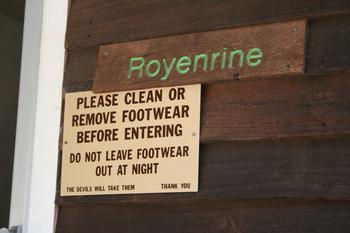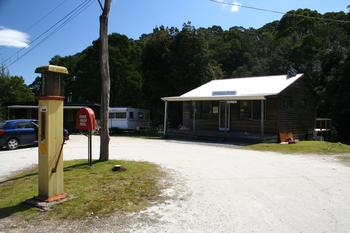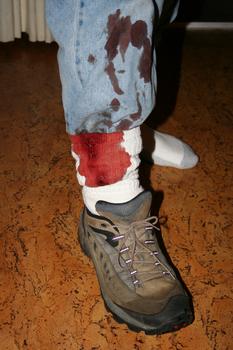Mount Wellington-Coast-to-Coast-Tasmanian Devils
As the local saying goes "we're busier than cats burying shit." I think the
latest we set out was 9, but that's because we both did stuff before that.
Normally we're out by 6:30. And not back until after 8 or 9. The receptionist at the Hobart hotel told Claudia that she wasn't
even sure whether we'd checked in or not (we never saw them—they had to leave
the key under the mat because we arrived so late). It has actually been a problem making time to eat. There's often only one place in town, and they serve from 6 to 8. We're not generally home by then.
Anyway, today we have the long trip diametrically across the country from the south eastern corner to the very tip of the north west. We decide that we should risk taking the longest and slowest route, right over the mountains of the central massif, which is by far the most interesting route, but we have a six o'clock deadline with Jeff King the Tasmanian Devil guy.
But before we can head in that general direction, first we need to complete our Hobart duties by summiting Mount Wellington which is in the diametrically wrong direction. So another 6:30 start.
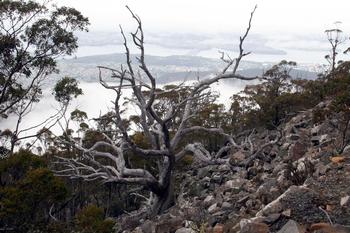 |
We pass right through the center of Hobart again. There are a dozen traffic lights, but we never stop. We keep to the speed limit so the lights keep changing just in front of us. What a concept. On the other side of town, the mountain road at first it is a typical suburban road with neat houses on both sides of the road, Hobart creeping like a fungus up the side of the mountain. But it soon takes on the more rugged, switchback-and-precipice feel of a serious climb. Also we disappear into the clouds. We stop to take a couple of shots of the view across the bay before we become completely enshrouded. |
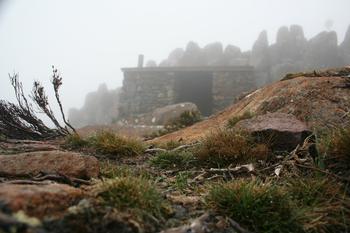 |
The top reminds me of a classic English mountain top—damp, windy, misty, and a few degrees above freezing, so it is impossible to keep warm. Or to keep equipment dry—if it is on the outside the mist congeals on it, if you pull it under cover then sweat steams it up. We spend five minutes checking out what little we can see, then mutually, silently, find ourselves scrambling to get back inside the car. |
We have to retrace our steps all the way down the mountain, back through Hobart and past the hotel, but 45 minutes later we are in virgin territory again.
|
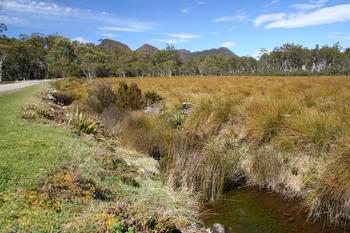 |
| Wombat dropping. Apparently famous for its rectangular shape, it is certainly distinctive and sparks a conversation about the physics of extruding such a sharply-cornered object. |
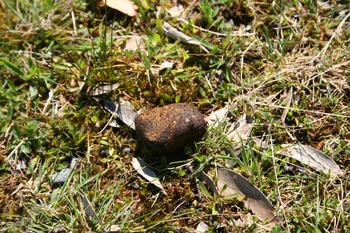 |
| We need to really keep on the move today, and although it is just a regular two lane road winding through little towns and miles and miles of sheep pasture, the lack of traffic allows us to keep up a steady pace. Gradually the farm land gives way to a more ancient landscape of myrtles and gums. Apparently we will travel through three or four distinct geographies as we cross the mountains. Late morning we finally stop in the middle of the Franklin-Gordon Wild Rivers National Park for a combination pit stop/photo op. |
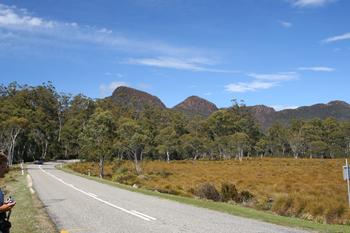 |
 |
Then on again, over the water shed and down into Queenstown. What a place. Again I'm reminded of the difference between a natural desert and a man-made wasteland. Queenstown sits on top of the mountains that tumble straight down into the sea on the west coast. And it sits in the middle of spoils of its own creation, the slag heaps, strip mines and barren hillsides left from a century of copper-mining. We stop to gas up, call home, (all the call boxes work in Australia) and gather pies and coffee for lunch. We also look again at the map. |
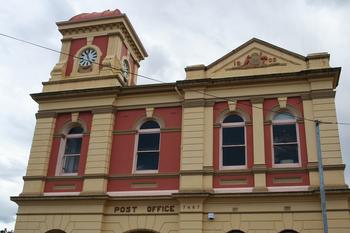 |
Bruny Island taught us that there's nothing rough and impassible about dirt roads—you might need a little more care and attention, but you don't need four-wheel drive. There's a dirt road that runs due north from where we are and it leads directly to where we need to be. As best as we can calculate it, it will save us about 50 miles. It will also, obviously, be far more interesting. We don't need to vote. |
| It is, nevertheless, more than 100 miles of road that is constantly changing in direction, pitch, and elevation. We're doing in excess of 50 miles an hour most of the time. The car drifts and slides across the ruts and over the marbles that the road bed seems to comprise of. When the ruts are perpendicular to the direction of travel, the washboard effect seems to leave the car suspended above the road just like aquaplaning. One just hopes there's no need for any serious velocity changes until the road smoothes out again. After an hour or so, we drift around a corner and where the road should be instead the Pieman river quietly waits for its next victim. |
 |
|
 |
 |
|
Mount Wellington
A drive up Mount Wellington (about 1⁄2 hr to the top from downtown Hobart)
will take you through wet schlerophyl forests and alpine heath. A stop around
the village of Ferntree is a great idea for wattlebirds and wrens. Many walking
trails are to be found on the north side of the mountain around Ferntree.
Tasmanian Devils
Today, devils are widespread in Tasmania from the coast to the mountains, and
are particularly common in some north, east and central districts where some
farming practices (e.g.,
rangeland sheep grazing)
provide much carrion.
They live in coastal
heath, open dry
schlerophyl forest, and
mixed
schlerophyl-rainforest– in
fact, almost anywhere
they can hide and find
shelter by day, and find
food at night. Tasmanian
devils can be seen in
many rural and
wilderness areas by
slowly driving at night
along secondary roads.
Devils are readily seen at
the Narawntapu NP, Mt.
William NP, Cradle Mt. NP , the Arthur River and highland lakes area. Look for
them a few hours after sunset.
Devil Facial Tumor Disease is a term used to describe a fatal condition in
Tasmanian devils which is characterized by the appearance of obvious facial
cancers. Adults appear to be most
affected by the disease – males the first affected, then females. Badly affected
devils may have many cancers throughout the body.
This disease was first noticed in NE Tasmania in the mid-1990s but has become
more prevalent in recent times. There is still no evidence of the disease in the State's far NW and W coast populations.
Marrawah is renowned for
being a great spot for surfing and fishing. More specifically, the area is well
known for its highly prized abalone shellfish. If you forget your line, Geoff King,
the third-generation owner of King's Run, will supply you with one. Marrawah
has some great places to grab a bite to eat and the local Marrawah Pub is the best
of them, with its beautiful pepper scotch fillet specialty.
Apart from that, there’s self-contained accommodation at Glendonald Cottage on
the Arthur River Road. The curve of Ann Bay here is shrouded by the hump of
Mount Cameron West to the north. Three km N of this bluff, at the end of a long
exposed beach, is the most complex Aboriginal art site in Tasmania: rock
carvings of geometric or non-figurative forms cover slabs of rock at the base of a
cliff. Aboriginal carvings at Mt Cameron West show a remarkable similarity to
carvings in Central Australia.
I spend the night at Glen Donald, a farm cottage in the far northwestern tip of the
island, where the following morning Geoff King, the man I have come all this
way to meet, arrives. A burly middle-aged man, Geoff tells me a little of his
story over a coffee. His was one of the first families to settle in this remote
district in the 1880s. Geoff has two farms, but one, King's Run, which I have
come to visit, 830 acres of coastal land, he stopped farming 10 years ago in order
to preserve its natural and Aboriginal heritage. We head down the coast, which
presents impossibly pretty vistas of cattle and beaches and wild ocean.
"I just felt guilty destroying the land," says Geoff, when I ask why he chose to
stop farming. "That's really why I did it."
All the land I have here so admired is, as Geoff points out, an Aboriginal
creation. The Aborigines' selective firing of the country over millenniums
cultivated the park-like country that so dazzled early explorers and ensured an
ecosystem rich in food. Grazing and cropping by colonists destroyed much of the
original ecology. King's Run, in contrast, has recovered much of its original
verdant appearance. The land everywhere attests to how people once lived here
in communities - shell middens, scatterings of scrapings and tools and, most dramatically, numerous large round depressions, some up to five yards in
diameter. These earthworks are hut depressions on which Aborigines once raised
their beehive huts, decorated on the inside with skins and feathers. The
depressions, I realize, sit in clusters, once the site of Aboriginal villages and
communities, now ghost towns in the middle of which I am standing. |
|
 | |
 |
|
The car comes to a rest so close to the water that we have to reverse back to read the instructions posted at the side of the road. It says "Press Button Once" We press the button once. Within a minute, a barge eases away from the opposite back and plies its way towards us. The fare is almost as much as the ferry to Bruny Island, but we're well and truly caught by the short and curlies.
We've arrived in Corrina, the only town between Queenstown and Murrawah, and we ask the ferryman about options for a cold one. "The pub is closed for renovations, but ask at the store." Almost as soon as we pull off the ferry we pass the pub, which is clearly the gutted shell of a building. Building is too grand a word—I've seen larger garden sheds. |
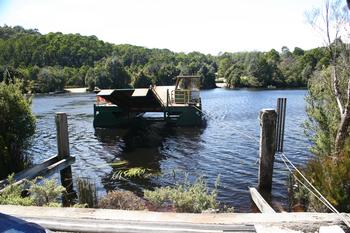 |
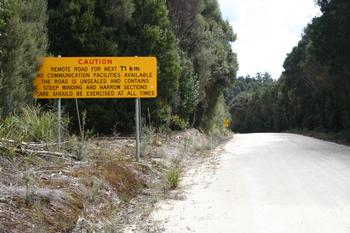
While we're enjoying the beer, the sunshine, and the quiet, a teenaged girl arrives, who clearly is the actual store keeper. Our $5 bill has sat on the countertop until she deals with it. We chat a while. Corinna has a population of four. We haven't met her mother, otherwise we'd have met everyone in town. (Yes, that would make five people in all—the first guy we met was a contractor "not from town"). |
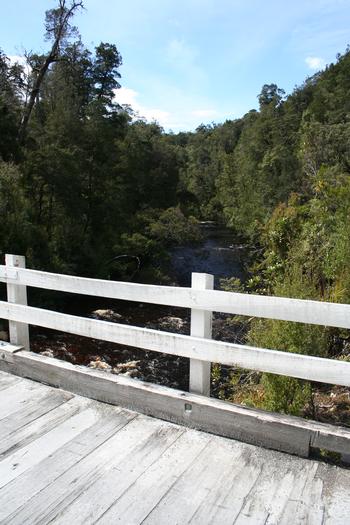 |
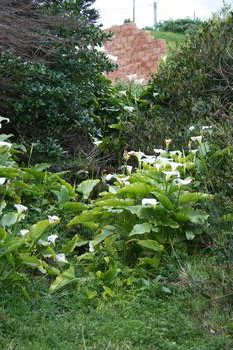 |
We have to get going, we have another 60 miles of up, down, and a little sideways to do yet, and we're driving against the clock. Finally, around 5pm, we roll into Murrawah and back into farming country: beef this time. The cottage is on the outskirts of the village, and we drive right past it the first time. When we find it, it is open. By the phone in the bedroom is a notice asking guests to call the host and hostess, who conveniently, are also our guides for tonight's Devil hunt. Jeff answers the phone. "G'day boys." He explains that he'll pick us up at about 6:30pm, and that we'll need to have eaten by then. Since, of course, the pub doesn't start serving food until 6:00pm, he calls them to let them know we're coming and that we "need to be in and out by 6:30." Sure enough, the barkeep is keen to take our order as soon as we walk in, and our order is ready by 6:05pm.
The Tasmanian Devils were, of course, incredible. We pulled off the road and Jeff got out and tied a possum carcass to the back, and adjusted the wheel hubs to low ratio-four wheel drive. Then we headed off across his brother's property for several really rough miles to the coast, and a small cottage at the head of the beach. As we are driving it becomes clear that we, but Wayne in particular, are Jeff's kind of people. They talk birds, and ecology which I'm a little better qualified to chime in on. Now that Jeff has confirmed that we're not city slickers, and since it was only twilight, he suggests we step out into rain to check some of the other wildlife. We crept around a headland and there were wallabies and pademelons all over the place.
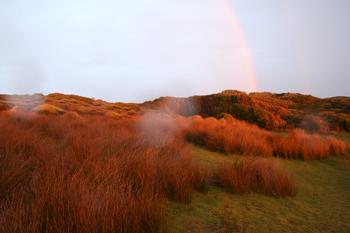 |
Suddenly the sun broke under the clouds and as it sunk below the horizon the light was absolutely magical. It was a desperate battle to keep the lenses dry, not drop anything into the ankle-deep marsh while I switched between lenses and capture the image while the light lasted (it was fading fast). We'll see how I made out when I get home and examine the images. |
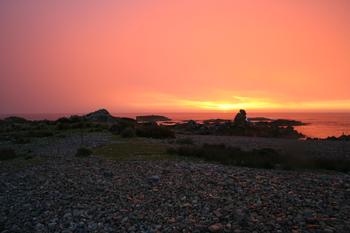 |
We retired to the cottage. Jeff says "what's that on your hand?" I look down and there are two slugs on my wrist. "Tiger leeches!" he says calmly. Calm maybe, but there's some urgency to get some salt on them, and in the rush I don't notice that the autofocus is still switched off, so there's no good record of this. But then Jeff says we should all strip to our skivvies to make sure there are not any more. No need. We look down, and my pant leg is covered in blood. This one already got away and was on the floor. Four inches long, though the size varies a lot. The inch-long slugs we salted off my wrist into a basin are already climbing out of it by stretching over the rim. Jeff takes them all outside.
Jeff has staked the possum carcass to the ground, and set up a lamp and a baby monitor outside the window. Then he opens a bottle of wine, and a snack of home-made humus and raw vegetables. He encourages us to help ourselves, but asks that we leave enough wine for him to join us later—he has a rule which prevents him from imbibing until we've seen at least one devil. Right on schedule, about an hour after sunset, the first Devil arrives. And then another. The scene of screaming, snarling, and fighting, interspersed by the focused chewing of the current victor belies description, and the monitor captures every crunch. I'd best not go on, but we were transfixed. I was very aware of the privilege of being in such a remote spot, with such knowledgeable companions, and most importantly of sharing such an intimate moment with these wild and shy creatures—truly this was the sort of scene most people only experience through television.
We watch for a couple of hours until the dinner is nearly all gone. The devils may be no bigger than a small dog, but they crunched their way through bone, fur, everything. Then Jeff suggests we do some night spotting on the way home. The three of us get back in the SUV and he sets off cross-country. It is rather disconcerting—he's holding a spotlight out of the window, but the headlights are off—so we're driving randomly across the countryside in complete darkness. I have no idea how we don't hit something or get bogged down. There is a staggering amount of activity. We must have seen 50 individual pademelons and wallabies, and two wombats. Jeff finally drops us off at home at 12:20am. Three hundred miles, eighteen hours, and what feels like a world and a lifetime away from Hobart. |
|
|









